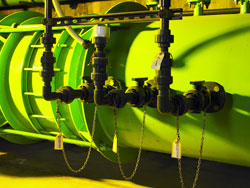THMs
Why Test Trihalomethane (THM) disinfection byproducts are formed by the reaction of chlorine with natural organic matter (NOM) present in the water. The concentration of THMs is regulated under the Safe Drinking Water Act. The majority of THMs are formed by the use of free chlorine as a disinfectant. The THM Plus method is available for screening for THM concentrations. Use the method to track THM formation at various locations within the treatment process and the distribution system. Monitor process changes to track the impact on THM formation. Establish a baseline and the normal daily variability in THM levels before making treatment changes.
THM Formation Potential
Why Test Source waters are tested to check for the potential of the water to form trihalomethane (THMs) disinfection byproducts when chlorine is used as a disinfectant. Chlorine concentrations, pH levels and temperature conditions can be varied to characterize THM formation conditions. The formation potential test can be modified to use the specific conditions of your source water, to investigate the demand from alternative surface water sources and to study the impact of weather events or other seasonal occurrences on treatment processes. The method can be applied to jar test waters to understand the effects of changing coagulants, reduction in TOC levels and the formation of THMs. Procedure modifications also allow Simulated Distribution System Trihalomethanes (SDS-THM) studies to be performed.
UV254
Why Test UV-254 is a measurement of the UV absorbing organic constituents at the 254 nm wavelength. This measurement has shown to be a good indicator of the amount of organic material present that is likely to react with chlorine to form disinfection byproducts. The method uses no reagents and requires an instrument capable of measuring at 254 nm. The method is best used with surface waters like large reservoirs or lakes that have a relatively stable organic level. A change in the UV 254 absorbance value can indicate changes in water quality that may impact the disinfection process. Storm events, algal blooms or reservoir turnover would be examples of events that could impact the UV-254 value and the subsequent treatment process. The UV-254 measurement is made following sample filtration through a 0.45 micron filter. The UV-254 value is also used in the calculation of SUVA which is used to determine compliance for reducing DBP precursor material under the Disinfectants and Disinfection Byproduct Rule.
TOC
Why Test Total organic carbon (TOC) is the amount of carbon in organic compounds present in a water sample. In surface water, the TOC is primarily from the natural decomposition of plant materials. The TOC is the primary source material for reacting with chlorine and other oxidants to form disinfection byproducts. The TOC values are monitored to determine source water quality, changes to the source water quality and to provide guidance in selecting a treatment strategy for its removal and management of disinfection byproduct formation. Individual treatment plants are required to achieve a specified percent removal of influent TOC between the raw water sampling point and the treated water TOC monitoring point. Strategies to minimize TOC in source waters are important in minimizing treatment costs and disinfection byproduct formation.
| Method |
Use Model |
Product |
| Colorimetric - Direct Method |
Lab |
DR 3900, DR 6000 |
| UV Oxidation Method |
On-line |
Chlorine Demand
Why Test Chlorine demand is a measure of the amount of chlorine consumed by a source water after a fixed time at a fixed pH and temperature. Organic materials, ferrous iron, reduced manganese, sulfide and ammonia are examples of species that consume chlorine during the disinfection process. A high chlorine demand suggests that disinfection byproducts may form if the demand is due to organics. Chloramines may be formed when ammonia is present and sulfides may be produced when sulfate reducing bacteria is present. The chlorine demand test can be modified to use the specific conditions of your source water or to investigate the demand from alternative groundwater sources.
Ammonia
Why Test Ammonia can reach several mg/L levels in groundwater systems, especially those located in agricultural areas. The ammonia levels can change seasonally and need to be monitored. The ammonia will react with chlorine to form chloramines, creating an uncontrolled chloraminated water. The chloramines can cause taste and odor issues and possible nitrification problems in the distribution system. The standard salicylate method for ammonia can be used to determine ammonia levels in the unchlorinated water.
Free Chlorine
Why Test Ammonia can be destroyed by taking the water through breakpoint chlorination. This means that free chlorine is added to the water to convert the ammonia into chloramines. The further addition of free chlorine converts or "breaks" the chloramines down into nitrogen gas and other volatiles species leaving only free chlorine as the residual disinfectant. Free chlorine is also added at the surface water intake or inlet to prevent growth of zebra mussels and Asiatic clams. DPD Free Chlorine can be used to determine when the desired free chlorine residual is reached. Another use of free chlorine is to oxidize iron and manganese to form insoluble precipitates which can be removed by filtration. Use the Indophenol Method for Free Chlorine to measure free chlorine when iron or manganese are present.




